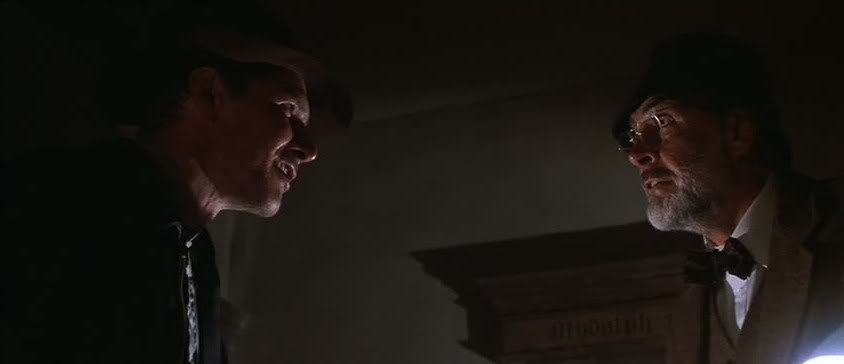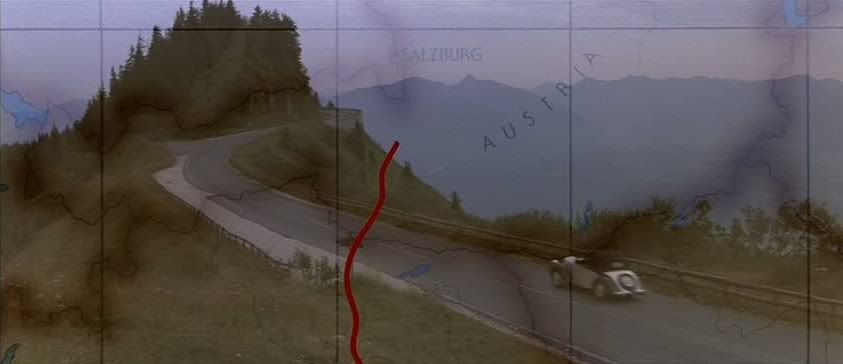
The third film in Steven Spielberg's Indiana Jones series was Indiana Jones and the Last Crusade, and after the strange, overblown tone of Temple of Doom (which chronologically serves as a prequel to the series), this film continues much more directly from Raiders of the Lost Ark. Once again, Indiana (Harrison Ford) must try to track down a legendary Christian relic — the Holy Grail this time — before it falls into the hands of the Nazis, even though one would think that the Nazis would have learned their lesson after the last time they actually got a hold of what they'd been searching for. The film is more than just a repeat of the formula from Raiders, though, because this time around, Indy's no longer a solitary adventurer, but is instead surrounded by both a literal and figurative family. Of course, the first two Indy films had sidekicks and accomplices who tagged along with the hero, but this time around he's gathered together a more substantial crew.
Foremost among them is Indy's father, Henry Jones (Sean Connery), who's been searching for the Grail for his entire lifetime, and who's been kidnapped by the Nazis as part of their quest to discover the source of eternal youth. Indy must rescue his father and find the Grail, aided by Raiders returnees Sallah (John Rhys-Davies) and Marcus Brody (Denholm Elliott), who in Raiders had been Indy's office-bound acquaintance, sending the adventurer off on his missions but never coming along himself. These men form a loose masculine family for Indy, a rough and ready band of friends and family. The film's last shot shows the four men riding off into the sun and the blood-red sky, an image right out of a Hollywood Western. This is especially appropriate because, more than in the other films, Spielberg is making Indy a cowboy archetype, with his signature hat and his horseback heroics.
The Western references start right with the film's first moments. The clever opening sequence is a referential, and self-referential, tour de force that continually subverts expectations with clever visual gags in which things are seldom what they seem. The first shot evokes the imagery of John Ford's Monument Valley, with a line of mounted riders winding through dirt trails between massive cliffs and red rock mountains. When Spielberg cuts in for the first closeup, though, he reveals that the riders are not Ford's cavalry but a troupe of Boy Scouts, even though they do have the yellow scarves that recall the uniforms of Ford's She Wore a Yellow Ribbon. Soon after, two of the Boy Scouts, hearing strange noises, wander into a cave and find some men eagerly excavating ancient relics from the rocks. One of the men has the familiar fedora of Indiana Jones, but Spielberg keeps his face hidden, first by shooting him from behind and then from slightly above, so that the brim of his hat shades his eyes, showing only the man's unshaven chin and square jaw. He looks like Indy, but it's not him: when he finally looks up it's a different man, and Spielberg quickly reveals that one of the Boy Scouts observing this scene is a young Indiana (River Phoenix), as an onscreen caption identifies the time and place as "Utah, 1912."
The subsequent chase scene, in which Indy boldly steals a valuable relic from the fortune-hunters, is full of in-jokes for fans of the franchise, suggesting where Indy's famous fear of snakes came from, showing the first time he experimented with using a whip, and tweaking audience expectations of Indy's flawless feats by having the young Indy leap off a rock to land on the back of a horse, only to miss and stumble as the horse simply steps forward. The whole sequence is relentlessly meta, building on the history and iconography of this character from the previous two films.


This is everything one would expect from an Indiana Jones movie, all staged with Spielberg's typical panache for action set pieces. There's a thrilling boat chase, and then later in the picture, Spielberg fakes out the audience by hinting that there's going to be a second one, only to have Indy and his dad jump on a motorcycle instead. There's a brief aerial dogfight, followed by a sequence — nodding to Hitchcock's North By Northwest, an obvious touchstone for this film's dashing, globe-trotting adventures — in which Indy and his dad flee on the ground while fighter planes swoop by overhead, raining down machine gun fire. There's a battle in which Indy, riding a horse, manages to outwit and take down a squad of Nazi soldiers and a tank. There's a trawl through underground catacombs filled with rats and a river of petroleum, which of course soon gets set afire. Indy even comes face to face with Hitler himself, in one of the film's more absurdly funny moments. There's a hilarious scene that wouldn't be out of place in a Marx Brothers spy spoof, where Indy and his dad keep spinning around as a secret panel opens up on a Nazi communications room. The thrills are perfectly paced, and the film barrels along at breakneck speed, with crackling dialogue to break up the action scenes.
Connery's Jones Sr. is especially compelling in that respect, perhaps because his dry wit and unflappable demeanor are linked to Indy's unhappy childhood with a mother who died young and a father who was distant and immersed in work. As the opening scenes show, Indy struggled to get his father's attention as a boy, and when he reunites with his father as a grown man, their relationship is uneasy and marked by dark humor. When Indy breaks into a Nazi castle to rescue his dad, Henry hits him over the head with a vase, at which point the two men immediately begin talking past one another: Henry is upset that he shattered what seems to be a valuable Ming vase, while Indy (incorrectly) reads his father's words as guilt over hurting his son. There's a lot of humor like this in the film, built around this father/son disconnection — even Indy's avoidance of the given name he inherited from his dad is evidence of their fraught relationship — and Indy's boyish desire to please his father. At one point, after father and son have evaded the Nazis during a violent and frenetic chase sequence, Indy lets out a whoop of excitement as they leave the last of their pursuers behind, but his smile fades when he sees his father's unimpressed, stoic expression and total disinterest in his son's love of adventure. Indy is a grown man but he still thirsts for fatherly approval, and because of this obvious subtext the film's bantering dialogue often has real bite.
The father/son dynamics are complicated by the presence of Elsa Schneider (Alison Doody), who turns out to be a Nazi but first sleeps with both father and son, which confirms the theme of Indy following in his father's footsteps. Schneider is an interesting character even beyond her importance to the father/son relationship. She's a surprisingly sympathetic Nazi whose allegiances are somewhat ambiguous; it's not at all clear just what she really believes or if her alliance with the Nazis is just a marriage of convenience to get her closer to the Grail, which she desires for her own unstated reasons. Even after she reveals her villainy, her affection for Indy and, to a lesser extent, his father isn't diminished at all. Her best moment, though, is a silent closeup as she watches Indy uncovering clues and preparing to break into a hidden passage through a wall in an underground chamber. She smiles sweetly and affectionately, her eyes shining with warmth: it's a very affecting and mysterious shot, because it suggests a depth of feeling in her that makes the revelation of her true nature somewhat hard to believe. Later, though, when she reveals her betrayal, her smile becomes crazed and sinister, her eyes wild.
The Last Crusade is a worthy successor to Raiders of the Lost Ark, abandoning the darkness and lurid violence of Temple of Doom in favor of the spirited adventure of the first Indy movie. Spielberg successfully channels the tone and the pleasures of that first film without simply duplicating it. It's a fun and exhilarating adventure flick and a worthy addition to the Indy canon.
I like the idea of Last Crusade more than the execution. The script (which I understand was doctored significantly by Tom Stoppard) has some clever ideas and funny zingers, but Spielberg's direction is surprisingly tepid. I've always wondered if that was a defensive reaction to the hostility that greeted Temple of Doom, where, to paraphrase Matt Seitz, he really let his id run wild. He seems anxious not to upset anyone this time out, to make the movie more family-friendly. There are still plenty of things I like about the movie, even though overall it's somehow less interesting to me than it should have been.
ReplyDeleteIt's definitely a self-consciously safer film, a return to the template of Raiders after the strangeness and camp of Temple of Doom. But for me it just works really well. It's fun, above all: the dialogue really crackles, and the Connery/Ford dynamic is fantastic. The ending isn't as good as the very similar conclusion to Raiders, but that's pretty much my only complaint here.
ReplyDeleteThere's also a weird moment of dubbing in the scene where Indy impersonates (badly) a Scotsman eager to see the tapestries in what is revealed as a Nazi hideaway. The butler originally said, "If you are a Scottish lord, I'm Jesse Owens!", historically accurate for the time period, but the filmmakers feared nobody would know who that was, so it was changed to Mickey Mouse. The dub isn't exactly seamless, though.
ReplyDeleteRiver
ReplyDeleteThis one has a special place in my heart -- I'm pretty sure my brothers and I saw it at least 5 or 6 times in the theater when we were kids and it quickly became our favorite film.
ReplyDeleteWith that in mind, I've always been a bit sheepish about defending the movie, figuring a lot of my defense of it is colored with nostalgia, so it's nice to see such a glowing appraisal from you on it, hitting on many of the same points that I've always claimed make it great (the Ford/Connery interplay, the use of Sallah and Marcus, the action setpieces, the verbal and visual zingers throughout, the intro scene).
Also -- Craig brings up a good point that this is Spielberg playing safe, yet better he plays it safe with what works than plays lazy and slack like he does in CRYSTAL SKULL (though in fairness, everyone except perhaps Karen Allen, is playing lazy in that movie).
Yeah it's a great one, Troy. It sticks to the formula of Raiders but does just enough different to avoid seeming like a simple retread of the first movie. Sure, it's not daring, but it's a blast as an action movie.
ReplyDelete